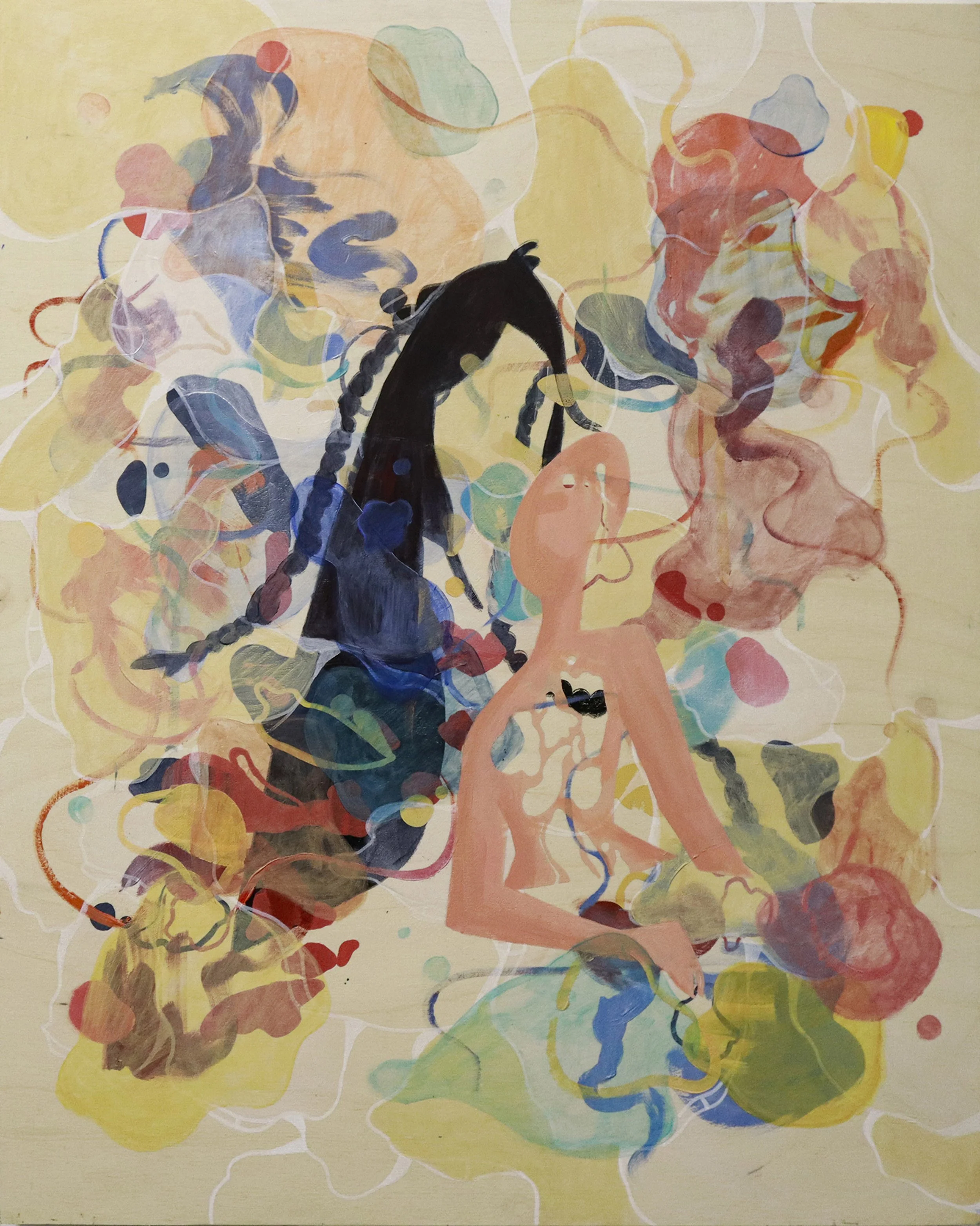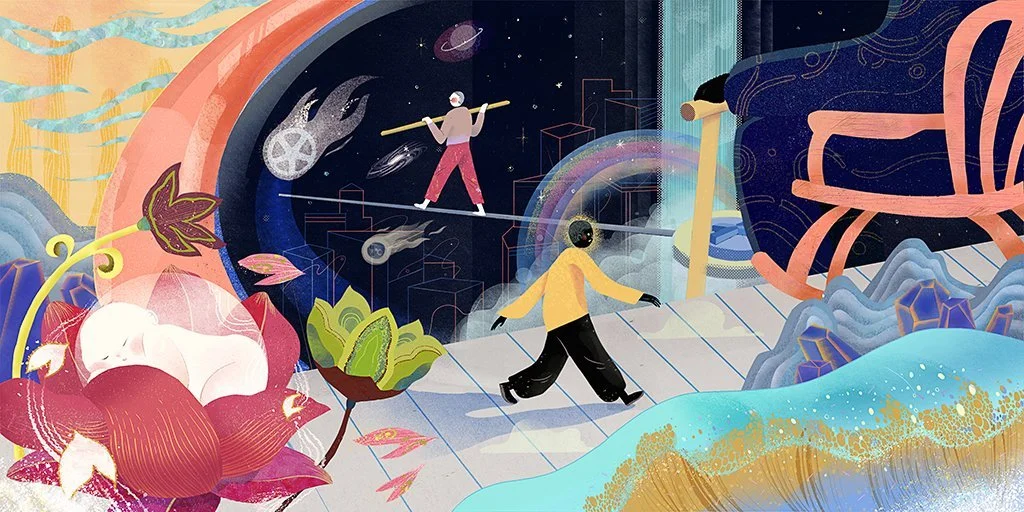10 Questions with Wei Zhang
Wei Zhang (she/her, Nanjing, China) is a visual artist passionate about colour, trained in Art Education at Nanjing Normal University and Painting at the Savannah College of Art and Design. Born and raised in Nanjing, a city where traditional architecture and modern skyscrapers coexist, her practice reflects diverse influences from this unique urban landscape. She currently works as a freelance artist in Atlanta. Working primarily with acrylic, screen printing, and digital media on raw wood panels, Zhang's practice centres on the concept of "containment" and the exploration of breaking beyond existing boundaries. Her creative process begins with emotions and memories that trigger visual subjects, frequently featuring human organs and cells as metaphors for human experience. Her paintings unfold through rich colours and layered applications, simulating the process of mechanical printing to create a sense that is both mechanical and organic. Through this mixed-media approach, Zhang surpasses her own boundaries and documents this journey, evoking emotions that everyone encounters. Her works prompt viewers to develop their own understanding of the concept and inspire them to break free from their own restraints, exploring the endless possibilities of human existence. Resonating with both the external world and inner self, Zhang's art strikes a chord within. Zhang's work has been exhibited in Atlanta, where she has also received multiple awards and recognition for her artistic achievements.
Wei Zhang - Portrait | TULA Art Center Exhibition Document, 2025
ARTIST STATEMENT
Wei Zhang's artistic practice centres on the concept of "containment" and the exploration of breaking beyond existing boundaries, both physical and psychological. A container can be a human organ, a closed-off memory, or the canvas itself, which became her container for recording emotions and experiences. Born and raised in Nanjing, China, a city where traditional architecture and modern skyscrapers coexist, her work reflects diverse influences that mirror her exploration of containment and liberation.
She works primarily with acrylic, screen printing, and digital media on raw wood panels, creating works that feel both mechanical and organic. Her creative process begins with a word or idea that triggers memories and emotions, which guide her choices in colour and form. Her work frequently features human organs and cells as metaphors for human experience, translated into organic shapes that serve as vehicles for colour.
Colour is the most essential language she uses to express feelings and her sense of self. She returns consistently to red, yellow, and blue, layering colours to transform flat surfaces into something three-dimensional. This rich layering simulates mechanical printing processes while maintaining an organic quality, creating a visual tension that mirrors her exploration of boundaries.
Through this mixed-media approach, Wei Zhang surpasses her own boundaries and documents this journey. Her works evoke emotions that everyone encounters, prompting viewers to develop their own understanding of containment and inspiring them to break free from their own restraints, exploring the endless possibilities of human existence.
Out of Box, screen print and acrylic, 14x14 in, 2025 © Wei Zhang
INTERVIEW
First of all, can you tell us a bit about your background and how you first became interested in art?
I grew up in Nanjing, China. When I was little, my aunt often taught me how to draw. I still remember her showing me how to turn a simple circle into many different kinds of spheres. That transformation felt magical to me. A single line could become an entire world of possibilities. That memory remains the foundation of my artistic curiosity today.
As a child, I loved colouring books. I could spend an entire afternoon quietly filling in shapes with watercolour pens. My mother would bring me new ones all the time, and I found comfort in that meditative process. Later, I majored in Art Education and then came to the U.S. to study painting at SCAD. Both experiences gave me the chance to explore a wide range of media and eventually discover the modes of expression that feel most authentic to me.
Your love for colour began with childhood colouring books. How are those early experiences mirrored in your artistic style today?
For me, colouring has always been a deeply soothing act. In contrast, early in my art education, I was trained to pursue realism, and the pressure to replicate reality often made me anxious. But colouring was different; it was pure enjoyment, free from judgment or technical expectation.
During graduate school, I realised I wanted to return to that simplicity. I thought: I don’t need to imitate what’s in front of me; I want to explore colour for its own sake. So I began painting intuitively, focusing on shape and hue rather than representation. It was liberating, like rediscovering the joy of childhood colouring books. That process, filling, layering, and balancing colours, has since evolved into the core language of my work.
Childhood 1, acrylic, 70x90 cm, 2021 © Wei Zhang
What draws you to use such bold and vibrant colours in your work?
In daily life, I’m quite a cautious person, but painting allows me to enter a freer space. My work often reflects what I’m experiencing emotionally at the time, and colour becomes a way to push beyond hesitation. I use the canvas to experiment, to do things visually that I might not do otherwise. The intense colour contrasts bring me energy and often help me process whatever I’m working through in life. Each painting feels like a resolution or release.
Could you describe your creative process? How do you usually begin a new piece?
I’m a very task-oriented person. I need a theme or a story to begin. Usually, I start with a word or idea that resonates with me, something that triggers memories or emotional images. Once I identify the feeling I want to convey, I look for visual metaphors.
Human organs and cellular forms often appear in my work because they carry strong emotional associations. From there, I sketch organic shapes that capture the rhythm of those ideas. I usually print a base layer using screen printing, then paint, draw, and print again to build layers. Dots, lines, and planes emerge naturally as I refine the composition. The process becomes a dialogue between intention and accident.
You often explore the idea of “containment” in your art. What does this concept mean to you personally?
When I was in college, I often struggled to start a piece. My professor suggested working from an abstract concept, so I chose “containment.” I soon realised how versatile it was. A container could be anything, a glass jar, a human organ, or even a sealed memory. The canvas itself became a container for my emotions.
At first, I simply painted containers, but gradually I began breaking their boundaries, turning that act into a metaphor for courage and self-expansion. Through this process, I learned to move past fear and restraint. I hope that, when people view my work, they also sense this emotional release, perhaps recalling something of their own that was once contained.
Under the Water, Acrylic on canvas, 48x24 in, 2022 © Wei Zhang
Under the Water 2, screen print and acrylic, 24x30 in, 2022 © Wei Zhang
How do you use abstraction and colour to express emotion or inner states?
The abstract forms in my paintings are created to serve colour. I sketch intuitively, each line or shape follows an emotional impulse. Colour is my most direct language for expressing inner experience. I’m often drawn to red, yellow, and blue, and I manipulate brightness and contrast to create movement within the surface.
Through layering, I try to make colours interact in space, almost as if they’re breathing. Calm feelings appear as cooler tones; joyful moments become vibrant collisions; complex emotions take the form of darker layers interrupted by bursts of intensity. Each piece becomes a visual rhythm that mirrors the emotional state I’m translating.
What materials or techniques do you enjoy working with the most?
I especially enjoy combining screen printing with painting on wood panels. There’s a particular beauty in transferring a digital design onto a tactile surface, it feels like a collaboration between mechanical precision and human touch.
Screen printing requires patience; every step demands focus. I often alternate between printing, painting, and printing again, letting each stage respond to the last. This back-and-forth process leads to unexpected textures and depth. Working this way has taught me one of the hardest lessons in art: understanding when to stop.
Are there particular artists, movements, or experiences that inspire your work?
Picasso has had a lasting impact on me. I once saw an exhibition that traced his life through different periods, and his Blue Period left a deep impression. The restrained palette carried such emotional weight; it showed how powerfully colour alone can convey loss and introspection.
I’m also inspired by his deconstruction of form, the way he broke and reassembled structures. That approach resonates with my own process of translating emotion into visual language through colour and shape.
Brain-solving Problem, Photo Litho, 15x11 in, 2022 © Wei Zhang
Heart in Darkness, Litho print, 15x11 in, 2022 © Wei Zhang
What projects are you currently working on, or what’s next for you?
I’m continuing to expand on the theme of “containment,” exploring how colour and form can express transformation. For the past two years, I’ve been merging screen printing with acrylic painting, and now I’m experimenting with translating organic shapes into representational imagery, portraying objects through layers of colour rather than outlines. I’m also exploring digital painting as an extension of my current practice.
And lastly, where do you see your artistic practice evolving in the next five years?
Over time, I’ve found the methods and materials that truly resonate with me. I’m particularly drawn to the dialogue between colour, transparency, and layering. In the next five years, I plan to deepen my exploration of how these elements can reshape the perception of form.
I also want to apply this language to figurative work, using my understanding of abstraction to interpret real subjects. Working on a smaller scale may allow me to concentrate on precision and subtlety, capturing detail while preserving emotional intensity.
Artist’s Talk
Al-Tiba9 Interviews is a promotional platform for artists to articulate their vision and engage them with our diverse readership through a published art dialogue. The artists are interviewed by Mohamed Benhadj, the founder & curator of Al-Tiba9, to highlight their artistic careers and introduce them to the international contemporary art scene across our vast network of museums, galleries, art professionals, art dealers, collectors, and art lovers across the globe.





















